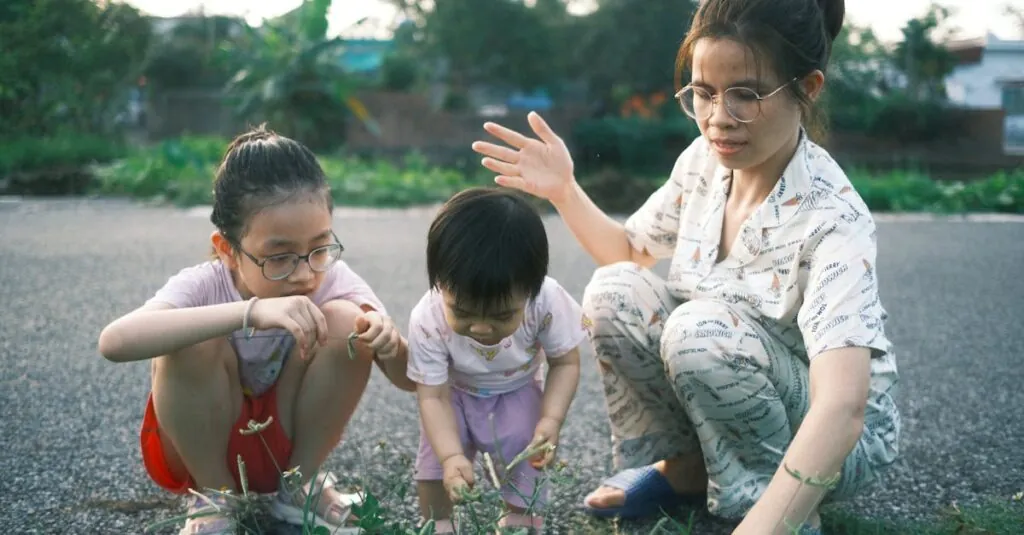In a world where kids seem to think they’re invincible, teaching natural consequences can feel like trying to herd cats—while blindfolded. Yet, this approach is not just about letting them learn the hard way; it’s about empowering them to make better choices. Imagine a life where kids actually understand the link between their actions and the outcomes. Sounds like a dream, right?
Table of Contents
ToggleUnderstanding Natural Consequences
Natural consequences occur when an individual’s actions result in outcomes without external intervention. This concept teaches children the significance of responsibility and decision-making.
Definition and Importance
Natural consequences refer to outcomes that happen as a direct result of a person’s actions. They encourage kids to consider their choices and grasp the implications of their behaviors. This understanding fosters accountability, allowing children to learn valuable life lessons without external punishment. A child who forgets their lunch might experience hunger, which serves as a powerful reminder to remember it next time. Through these experiences, kids develop critical thinking and problem-solving skills while gaining insight into the cause-and-effect relationship present in their daily lives.
Examples of Natural Consequences
Examples illustrate the effectiveness of natural consequences as teaching tools. A child who stays up late will likely feel tired the next day. When a teenager neglects their homework, missing grades might follow. If a child chooses not to wear a coat on a chilly day, they experience coldness. Through these situations, children learn both immediate and long-term effects of their actions. The experiences lead to self-awareness and encourage mindful decision-making in similar future scenarios. By repeatedly encountering natural consequences, kids can better appreciate how their choices shape their lives.
Benefits of Teaching Natural Consequences
Teaching children natural consequences has several notable benefits. These advantages support their growth and development in critical areas.
Promoting Responsibility
Natural consequences instill a sense of responsibility in children. They begin to understand that their actions directly affect outcomes. A child neglecting to do homework experiences poor grades, which highlights the need for accountability. This connection encourages them to take ownership of their tasks and decisions. Additionally, recognizing their role in events leads to the development of trust with caregivers. Caregivers foster independence when they allow children to face the outcomes of their choices. As children learn to manage responsibilities, they build a foundational skill set for adulthood.
Enhancing Problem-Solving Skills
Facing natural consequences also sharpens children’s problem-solving skills. When children encounter difficulties due to their choices, they learn to evaluate situations critically. For instance, a child who forgets their jacket on a cold day learns to plan ahead for future outings. This experience fosters adaptability and creative thinking. Children assess their mistakes and develop strategies to address them effectively. Encouraging these thought processes allows children to tackle more complex problems as they grow. Ultimately, enhancing problem-solving skills equips them to navigate challenges throughout life.
Strategies for Teaching Natural Consequences
Teaching natural consequences effectively relies on structured strategies. Creating the right environment and offering supportive dialogue fosters meaningful learning experiences.
Creating a Safe Environment
A safe environment encourages children to experiment with their choices. Comfort allows them to face the results of their actions without fear. Parents and educators should establish trust and openness, making it easy for kids to share their thoughts. Space for mistakes builds resilience and accountability, reinforcing the connection between action and outcome. Observing others experience natural consequences also provides valuable insights. Children can learn and relate, internalizing lessons on responsibility through their own experiences and those of peers.
Guiding with Supportive Dialogue
Supportive dialogue serves as a crucial tool in teaching natural consequences. Engaging children in conversations about their choices encourages reflection. Asking open-ended questions can help them think critically about outcomes. For instance, instead of simply pointing out a mistake, guiding them to express their feelings stimulates understanding. Affirming their thoughts validates their feelings. Discussing previous experiences, where natural consequences played a role, provides context and deepens comprehension. Listening actively while they share their reflections encourages accountability and problem-solving, essential skills for their development.
Challenges in Teaching Natural Consequences
Teaching natural consequences involves navigating various challenges that can hinder the learning process. Understanding these obstacles helps caregivers effectively guide children in their decision-making.
Common Misconceptions
Misunderstanding natural consequences often leads to ineffective teaching strategies. Some believe this method allows children to face harsh outcomes without support, neglecting the importance of guidance. Others confuse natural consequences with punishment, leading to a negative association. Parents may worry that allowing children to fail could damage their self-esteem. In reality, enabling children to experience appropriate consequences promotes growth and resilience. Shifting this mindset fosters a constructive environment for learning.
Dealing with Resistance
Resistance from children can pose significant challenges to this learning approach. Kids may initially refuse to accept responsibility for their actions, resulting in frustration for caregivers. Encouragement plays a vital role in overcoming this hurdle. Offering time and space to process their experiences allows children to reflect on their decisions. Engaging in open discussions about past situations helps them understand connections between choices and outcomes. Validating their feelings throughout this process promotes trust and a willingness to embrace accountability.
Teaching children about natural consequences is a powerful tool in their development. By allowing kids to experience the outcomes of their actions, they learn responsibility and decision-making skills that shape their future. This approach not only fosters accountability but also encourages critical thinking and problem-solving abilities.
Creating an environment where children feel safe to explore their choices is essential for this learning process. Through supportive dialogue and open discussions, caregivers can guide children toward understanding the direct impact of their actions. Embracing natural consequences ultimately equips children with the resilience and adaptability needed to navigate life’s challenges, laying a strong foundation for their growth into responsible adults.





